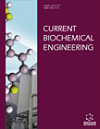Current Biochemical Engineering (Discontinued) - Current Issue
Volume 7, Issue 1, 2021
-
-
A Critical Review of the Biological Processes in the Chemical Absorption- Biological Reduction Integrated System for NO Removal
More LessBy Wei LiExploring low-cost, green, and safe technologies to provide an alternative to the conventionally selective catalytic reduction process is key to control the NOx emission from small-scale boilers and other industrial processes. For meeting this demand, the chemical absorption-biological reduction integrated system has been developed recently. This system applies Fe(II)EDTA for NO absorption and for the absorbent regen Read More
-
-
-
Recent Developments in the Downstream Processing of Phycobiliproteins from Algae: A Review
More LessAlgae (both micro and macro) have gained huge attention in the recent past for their high commercial value products. They are the source of various biomolecules of commercial applications ranging from nutraceuticals to fuels. Phycobiliproteins are one such high-value low volume compounds that are mainly obtained from micro and macroalgae. In order to tap the bioresource, a significant amount of work has bee Read More
-
-
-
Scope and Challenges of 3D Printing in Organ Transplantation
More LessAuthors: Naman Shah, Sarthak Jain, Priyal Jain and Mamta ThakurBackground: The influx of 3D printing in organ transplantation is currently a rigorous area of research, and its success is still cynical. This review article focuses mainly on the scope and challenges in the applications of 3D printing in organ transplantation. The basic idea of the article is to highlight the current status of 3D printing in the area of organ transplants. Introduction: The review article covers the highlights about th Read More
-
-
-
Technology and Application of Hairy Root Culture in Monocotyledons
More LessAuthors: Chang-Qi Hao, Shuai-Run Wang, Yi Wang, Xin-Yi Hou, Ya-Xuan Jiang, Bo-Wen Jiang, Xiu-Li Zhang, Xin Hua and Zhe-Yong XueBackground: Hairy root culture has been widely used in the production of metabolites in dicotyledons, and a large number of food crops and medicinal plants in monocotyledons need to be developed. However, there are many difficulties in the induction of hairy roots in monocotyledons. The purpose of this paper is to introduce the inducing methods, influencing factors, and application of hairy roots in monocotyledons, an Read More
-
-
-
Microbially Derived Co-Products from Zero-Discharge Aquaculture
More LessBackground: Global seafood production has doubled over the last two decades with aquaculture now contributing nearly 50% of supply. Pressure to reduce or eliminate water and waste discharge from aquaculture increases with each passing year. In response to this pressure, producers have adopted increasingly sophisticated technology, expanding fish and shellfish production from 2,000 kg/ha to over 40,000 kg/ha. While wat Read More
-
-
-
Theoretical Analysis of Single-Stage and Multi-Stage Monod Model of Landfill Degradation Through Mathematical Modelling
More LessBackground: Preventing substantial environmental hazards caused by noxious gases and solutes from sanitary landfills necessitates adequate regulations that require knowledge of the underlying mechanisms involved and the effect of various strategies. Mathematical models have been used to understand the development of landfill gas based on sequential biological growth and certain simple chemical and physical proc Read More
-
-
-
s New Green Animal Waste Hydrolysis Initiated by Malic Acid
More LessAuthors: Jiri Hanika, Milena Rouskova, Stanislav Sabata, Frantisek Kastanek and Olga SolcovaBackground: A giant amount of poultry waste represents one of the threats to the environment, or conversely, a significant source of peptides and other substances in demand. Rational use of huge quantities of poultry waste, especially after industrial chicken processing, is one of the pillars of biorefinery of animal wastes. Introduction: Six different animal wastes: chicken feathers, cartilages and the residue after meat separatio Read More
-
-
-
Utilization of Semi-continuous Algae Culture for the Treatment of Recycled Dairy Lagoon Wash Water
More LessAuthors: Gregory Schwartz, Mark Ibekwe, Tryg Lundquist, Shelton Murinda and Marcia MurryBackground: Utilization of animal wastes in algal culture has proven to be challenging. The utilization of “free” nutrients has drawn researchers and industry to develop business models that call for the use of these free nutrients, which comes at a cost. Some of these costs include reduced productivity, increased contamination, lower value target markets, and lower treatment capabilities (for wastewater treatment applicati Read More
-
-
-
Isolation of PHB Producing Yeast from Soil and its Quantification
More LessAuthors: Varsha Varghese and Sheela ShylajaBackground: Plastics are widely used in almost every manufacturing industry ranging from automobiles to medicine. Plastics take years to get degrade and have become a threat to the environment. Therefore there is a necessity to use biodegradable plastics in place of such nonbiodegradable plastics. Polyhydroxybutyrate or PHB is a type of biopolymer which has similar properties to that of synthetic plastics Read More
-
Most Read This Month Most Read RSS feed
Article
content/journals/cbe
Journal
10
5
false
en


